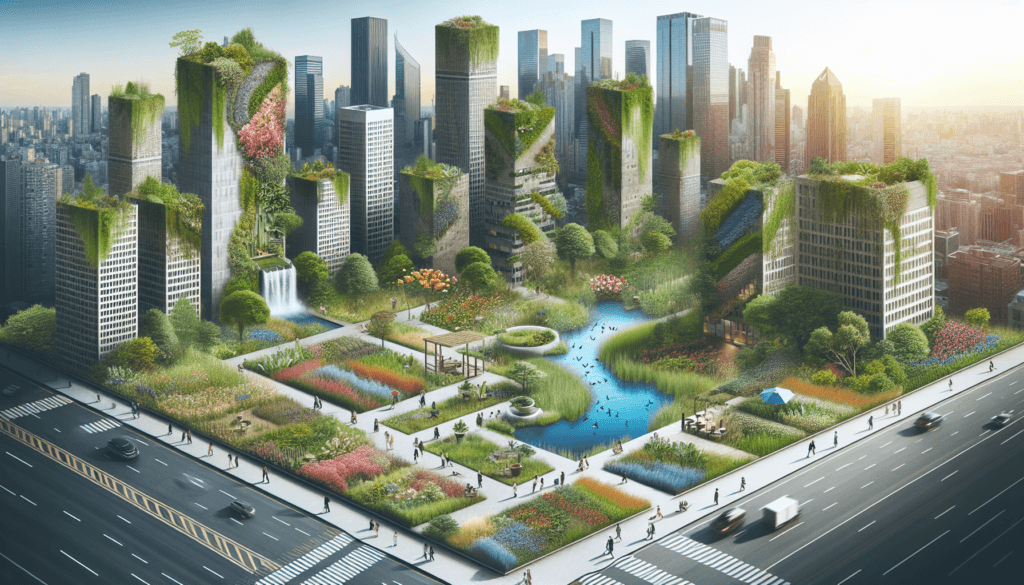Are you living in a bustling city and longing for a peaceful nature retreat? Look no further than your own backyard! In this article, we will provide you with some valuable urban gardening tips on how to transform your urban space into a healing garden. Whether you have a small balcony or a rooftop terrace, these tips will help you create a serene oasis filled with lush greenery and blooming flowers, offering you a much-needed respite from the hustle and bustle of city life. So roll up your sleeves, grab your gardening tools, and let’s get started on creating your very own urban oasis!

Choosing the Right Plants
Determining the Climate and Conditions
When choosing plants for your urban garden, it’s essential to consider the climate and conditions of your specific location. Take note of the average temperature, sunlight exposure, and wind patterns in your area. Some plants thrive in hot and sunny spots, while others prefer shady or cool environments. Understanding the microclimate of your urban space will help you select the right plants that will flourish in your garden.
Selecting Plants with Healing Properties
One of the benefits of urban gardening is the opportunity to create a healing garden. Many plants have medicinal properties that can promote well-being and reduce stress. Consider incorporating plants like lavender, chamomile, and aloe vera, which are known for their soothing effects. Herbs like peppermint and rosemary can also be grown for their culinary and healing properties. By carefully selecting plants with healing properties, you can create an urban garden that not only looks beautiful but also serves as a source of natural remedies.
Considering Size and Space Requirements
When planning your urban garden, it’s important to consider the size and space requirements of the plants you choose. Some plants, like fruit trees or large shrubs, may require ample space to grow and spread their roots. If you have limited space, opt for dwarf or compact varieties of plants that can thrive in containers or raised beds. Vertical gardening techniques, such as trellises or hanging baskets, can also maximize space utilization in small urban gardens. By carefully considering the size and space requirements of your plants, you can ensure that they have enough room to flourish and avoid overcrowding.
Creating a Functional Layout
Designing Zones for Different Activities
To make the most of your urban garden, it’s helpful to design different zones for various activities. Consider creating separate areas for gardening, relaxation, and entertainment. Designate a space for growing vegetables or herbs, another area for seating or outdoor dining, and perhaps even a section for a play area if you have children. By strategically planning and dividing your garden into functional zones, you can maximize the usability of your urban space and cater to different activities and needs.
Maximizing Vertical Space with Trellises and Planters
In urban gardens where horizontal space is limited, maximizing vertical space is crucial. Utilize trellises, arbors, or walls to support climbing plants such as vines or espalier fruit trees. Vertical planters or hanging baskets can also be used to grow flowers or herbs. These vertical gardening techniques not only optimize space but also add visual interest to your urban garden. By creatively utilizing vertical space, you can achieve a lush and vibrant garden even in the smallest of urban spaces.
Providing Easy Access to Pathways and Seating
When designing your urban garden, it’s important to ensure easy access to pathways and seating areas. Consider the placement of your plants and structures to create clear and inviting pathways throughout the garden. Use stepping stones or pavers to define the pathways, making it easier to navigate through the space. Additionally, provide comfortable seating options such as benches or chairs, allowing you to relax and enjoy your garden oasis. By prioritizing easy access and comfort, you can create a welcoming and functional urban garden.
Optimizing Soil and Drainage
Assessing Soil Quality and pH Levels
Before planting in your urban garden, it’s crucial to assess the quality of your soil. Urban environments may have soil that is depleted or contaminated, so it’s important to test for pH levels and nutrient deficiencies. Soil testing kits or services can provide valuable insights into the soil composition and help you determine if any amendments are needed. Adjusting the pH and providing appropriate nutrients will create optimal conditions for your plants to thrive.
Improving Drainage in Urban Environments
Urban environments often pose challenges when it comes to drainage, as concrete surfaces can hinder natural water flow. To improve drainage in your urban garden, consider using raised beds and containers with adequate drainage holes. Incorporate organic matter into the soil, such as compost or peat moss, to improve water retention and prevent waterlogging. Proper drainage will prevent water accumulation and ensure the health of your plants, mitigating the risks of root rot and other water-related issues.
Amending Soil with Organic Matter and Nutrients
In urban gardening, it’s common to encounter soil that lacks essential nutrients. To address this, incorporate organic matter into your soil to enhance its fertility and structure. Compost, well-rotted manure, or worm castings are excellent options for adding organic matter. These natural amendments enrich the soil with vital nutrients and improve its ability to retain moisture. By amending your soil with organic matter, you can create a nutrient-rich environment that supports robust plant growth in your urban garden.
Implementing Sustainable Watering Systems
Collecting Rainwater for Irrigation
Water scarcity is a concern in urban environments, making sustainable watering systems essential for urban gardening. One effective method is rainwater harvesting, where you collect rainwater from rooftops or other surfaces. Set up rain barrels or cisterns to capture and store rainwater for future use in your garden. This method not only conserves water but also provides a natural and chemical-free source of irrigation. By utilizing rainwater, you can promote sustainability in your urban garden and reduce reliance on municipal water supplies.
Installing Drip Irrigation Systems
Drip irrigation systems are another efficient way to water your urban garden. These systems deliver water directly to the plant’s root zone, minimizing water evaporation and overspray. By using drip irrigation, you can ensure that your plants receive consistent moisture while minimizing water waste. Additionally, drip irrigation systems can be set on timers, providing convenience and reducing the effort required for watering. Installing a drip irrigation system will help you maintain the health of your plants and efficiently use water in your urban garden.
Utilizing Self-Watering Planters
For urban gardeners with limited time or those who travel frequently, self-watering planters can be a game-changer. These planters have a built-in reservoir that provides a steady water supply to the plants as needed. Self-watering planters reduce the risk of overwatering or underwatering, as the plants can draw water from the reservoir as required. By using self-watering planters, you can ensure that your plants remain hydrated even during periods of neglect or absence.

Controlling Pests and Diseases Naturally
Attracting Beneficial Insects and Birds
In an urban garden, controlling pests and diseases naturally is crucial to maintaining a healthy and thriving garden ecosystem. One effective method is attracting beneficial insects and birds to your garden. Plant native flowers, herbs, or grasses that provide nectar, pollen, or seeds to attract beneficial insects like ladybugs, lacewings, or bees. Birds such as bluebirds or titmice feed on harmful insects, keeping their populations in check. By creating a welcoming environment for beneficial creatures, you can naturally control pests and promote a balanced ecosystem in your urban garden.
Using Companion Planting Techniques
Companion planting is a well-known technique used in organic gardening to control pests and enhance plant growth. Certain plants have natural properties that repel pests or attract beneficial insects. For example, planting marigolds near tomatoes helps deter nematodes, while planting basil near peppers repels aphids. By strategically combining compatible plants in your urban garden, you can create a natural defense against pests and promote healthier plants without relying on chemical pesticides.
Making Natural Pest Sprays
When faced with pest issues in your urban garden, natural pest sprays can be a safe alternative to chemical insecticides. Homemade sprays using ingredients like neem oil, soap, or garlic can effectively control common pests. These natural solutions repel or suffocate pests without harming beneficial insects or posing risks to human health. By making your own natural pest sprays, you can ensure a safer environment for both your plants and yourself.
Creating an Engaging Sensory Experience
Incorporating Fragrant Plants and Herbs
To enhance the overall sensory experience of your urban garden, consider incorporating fragrant plants and herbs. Lavender, jasmine, or roses can fill the air with delightful scents, creating a relaxing and soothing ambiance. Additionally, culinary herbs like mint, basil, or thyme release aromatic fragrances when brushed against or crushed, further stimulating the senses. By introducing fragrant plants and herbs, you can transform your urban garden into a sensory oasis, providing a calming and refreshing experience.
Adding Texture and Interest with Different Leaf Shapes
Incorporating plants with various leaf shapes can add visual interest and texture to your urban garden. Choose plants with contrasting leaf sizes, shapes, and colors to create an engaging and dynamic aesthetic. For example, combine plants with broad, lance-shaped leaves with those featuring delicate, fern-like foliage. This diversity in leaf shapes adds depth and complexity to your garden design, making it visually appealing even in urban environments.
Integrating Sound Elements like Water Features or Wind Chimes
Sound can enhance the sensory experience in your urban garden. Consider integrating elements like water features or wind chimes to create soothing sounds that mask urban noise. A small fountain or water feature can provide the tranquil sound of flowing water, creating a peaceful and serene atmosphere. Wind chimes add musical notes to the garden, creating a melodic background that’s pleasing to the ears. By incorporating sound elements, you can create a multi-dimensional sensory experience in your urban garden.

Enhancing Privacy and Noise Reduction
Using Tall Plants or Trellises as Privacy Screens
Privacy can be a concern in urban gardens, especially those surrounded by neighboring buildings or busy streets. To enhance privacy and create a tranquil space, use tall plants or trellises as privacy screens. Choose fast-growing, dense plants like bamboo or climbing vines to create a natural barrier. Alternatively, install trellises or lattice panels that can support climbing plants, providing both privacy and visual interest. By strategically positioning tall plants or trellises, you can create a private sanctuary in your urban garden.
Installing Water Features for Masking Noise
Noise pollution is a common issue in urban environments, and incorporating water features in your garden can help mask undesirable sounds. The gentle sound of flowing water from a fountain or waterfall can drown out traffic noise, creating a more serene outdoor space. Choose a water feature that fits your urban garden’s size and design, ensuring it provides the desired effect without overwhelming the space. By installing water features, you can transform your urban garden into a peaceful refuge from the hustle and bustle of city life.
Utilizing Sound-absorbing Materials in Hardscaping
In addition to using plantings and water features, selecting sound-absorbing materials for hardscaping can further reduce noise in your urban garden. Consider incorporating materials like wood, cork, or fabric, which can absorb sound rather than reflecting it. Use these materials for features such as fences, decking, or seating areas to create a quieter environment. By utilizing sound-absorbing materials, you can improve the acoustic environment in your urban garden and make it a more peaceful and enjoyable space.
Designing for Accessibility
Ensuring Wide Pathways for Wheelchairs or Strollers
Designing an urban garden that is accessible to everyone is important. When planning your garden layout, ensure that you have wide and smooth pathways that accommodate wheelchairs, strollers, or mobility aids. Avoid uneven surfaces, steps, or narrow passages that can pose barriers to accessibility. By considering the needs of all users, you can create an inclusive and welcoming urban garden for everyone to enjoy.
Creating Raised Beds for Easy Reach
Raised beds are an excellent solution for urban gardening as they provide easy access to plants and minimize the need for bending or kneeling. By elevating the planting area, raised beds make gardening more accessible for people with limited mobility or back problems. The height of the raised beds can be customized to suit individual needs, ensuring easy reach and comfortable gardening. Creating raised beds will enable you to enjoy the benefits of gardening while maintaining comfort and accessibility in your urban space.
Providing Seating Areas with Back Support
Incorporating seating areas with back support is essential to provide comfort and relaxation in your urban garden. Choose seating options that have proper backrests, such as benches or chairs with lumbar support. These seating areas not only provide a space to rest and unwind but also promote inclusivity and accessibility for individuals with mobility limitations. By ensuring comfortable seating with appropriate back support, you can create a garden that invites people to take a break and enjoy the beauty of nature.

Using Creative Containers and Vertical Gardens
Exploring Vertical Garden Options
Vertical gardens are a popular choice for urban gardening, allowing you to utilize limited space effectively. Explore options such as living walls, green facades, or modular vertical planters. These innovative solutions allow you to grow plants vertically, either by attaching them to walls or using freestanding structures. Vertical gardens not only provide additional growing space but also create striking visual displays, adding a touch of elegance to your urban garden.
Repurposing Everyday Items as Planters
When it comes to containers for your urban garden, don’t limit yourself to traditional pots and planters. Get creative and repurpose everyday items such as buckets, old tin cans, or wooden crates. These unique containers not only add a rustic and eclectic charm to your garden but also reduce waste by repurposing items that would otherwise end up in the trash. By thinking outside the box, you can add a personal touch to your urban garden while being environmentally conscious.
Utilizing Hanging Baskets and Window Boxes
Hanging baskets and window boxes are excellent options for adding greenery to limited urban spaces. Hang baskets from walls, railings, or pergolas to create a floating garden effect. Window boxes can be installed on the exterior of your windows or balconies, adding lushness to vertical surfaces. These versatile containers provide flexibility in gardening and enable you to introduce plants at eye level, brightening up your urban environment. By utilizing hanging baskets and window boxes, you can make the most of every available space in your urban garden.
Maintaining and Caring for Your Urban Garden
Pruning and Trimming Plants Regularly
Regular pruning and trimming are crucial for maintaining the health and aesthetics of your urban garden. Remove dead or damaged branches, foliage, or flowers to promote healthy growth and prevent the spread of diseases. Trim overgrown plants to maintain their size and shape, ensuring they don’t overwhelm the space. By regularly tending to your plants, you can keep them in optimal condition and maintain the beauty of your urban garden throughout the year.
Monitoring Soil Moisture and Fertilizer Needs
Monitoring soil moisture and fertilization is essential for the overall well-being of your plants. Depending on their specific needs, some plants may require more water or nutrients than others. Use a moisture meter or stick your finger an inch deep into the soil to gauge moisture levels. Adjust your watering schedule or irrigation system accordingly to prevent overwatering or underwatering. Similarly, monitor the fertilizer needs of your plants and provide appropriate nutrients when necessary. By keeping a close eye on soil moisture and fertilization, you can ensure that your plants receive optimal care and thrive in your urban garden.
Protecting Plants from Extreme Weather Conditions
Extreme weather conditions can pose challenges to urban gardeners, but with proper care, your plants can withstand these conditions. Protect your plants from excessive heat by providing shade or using shade cloth during peak sunlight hours. Shield them from strong winds by using windbreakers or placing them in sheltered areas. Cover plants during cold snaps or frost to prevent damage. By taking proactive measures to protect your plants from extreme weather, you can help them thrive and ensure the longevity of your urban garden.
Creating a healing garden in urban spaces requires thoughtful planning and attention to detail. By considering the climate and conditions, selecting the right plants, designing a functional layout, optimizing soil and drainage, implementing sustainable watering systems, controlling pests and diseases naturally, enhancing the sensory experience, enhancing privacy and noise reduction, designing for accessibility, using creative containers and vertical gardens, and maintaining and caring for your urban garden, you can create a sanctuary of tranquility and well-being in the midst of the city. Happy gardening!


